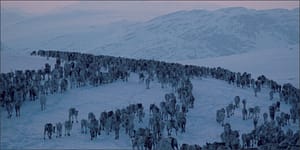Appetite For Construction

Have you ever wondered why beavers build dams the way they do? Believe it or not, there is actually a method to the madness. Similar to the motives behind why humans manipulate the environment the way they do, beavers employ a strategic plan when building their dams. The animals are “among our closest ecological and technical kin,” says Beaver-Believer and author Ben Goldfarb. Continue reading to learn more about their building techniques and if you’re looking for more Beaver 101 see our other excerpts on why beavers matter and how they made Teddy Roosevelt a conservationist.
The following excerpt is from Eager by Ben Goldfarb. It has been adapted for the web.
I first visited the abandoned house on a September day with my friend Leah, a local who was aware of my beaver obsession. Around eight miles outside of Taos, we pulled off the road to admire the site. Calling it a “beaver pond” scarcely did it justice—“beaver industrial complex” seemed more apt. The resident rodents had laid down a hefty blockade of branches, some six feet tall and fifty feet long, in the middle of the Rio Hondo, diverting the creek into the front yard of a small red cottage with a peaked 
Although the property owners probably weren’t too pleased, the compound was, to my eye, a magnificent feat of infrastructure. Each disparate design element functioned in harmony: The half-dozen adjunct dams, placed with surgical precision, shunted water into the spidery canals winding into the willows, an intricate network of channels that permitted the miniature Venetians to fell and transport trees without risking dangerous overland travel. Below the dam the river raced white-flecked and implacable; above, it spread serenely over grass and cobble, a half-acre harbor. More remarkable than the compound’s immensity was its sophistication, the way the creatures had melded environment and architecture with an adroitness that recalled Frank Lloyd Wright. Leah, a relative beaver neophyte, was gobsmacked. “This is so impressive,” she said, and I had to agree.
How do beavers engineer such epic works—and why go to such elaborate lengths? The primary reasons are the same ones that first drove humans to build domiciles of their own: safety from predators, shelter from the elements, and food storage. On land, beavers—North America’s biggest rodent, and the world’s second largest, after South American capybaras— are ungainly and vulnerable, and their pear-shaped bodies make delectable meals for black bears, cougars, coyotes, and wolves. Yet beavers are as balletic in water as they are clumsy out of it. They can hold their breath for up to fifteen minutes, and their underwater gymnastics are powered by webbed hind feet. Transparent eyelids allow them to see below the surface, while a second set of fur-lined lips close behind their teeth, permitting them to chew and drag wood without drowning. Building dams expands the extent of beavers’ watery domains, submerges lodge entrances to repel predators, and gives them a place to stash their food caches. Ponds also serve to irrigate water-loving trees like willow, allowing beavers to operate as rotational farmers: They’ll chew down vegetation in one corner of their compound while cultivating their next crop in another.

Recent Articles
This long-lived perennial legume is used for forage and erosion control. Kudzu is edible with many medicinal uses and other applications. Pollinators of all kinds love its prodigious lavender blooms!
Read MoreMove aside, maple! We have two new syrups to add to the table. Read on for insights on tapping, selling, and eating syrup from walnut & birch trees.
Read MoreWhy is modern wheat making us sick? That’s the question posed by author Eli Rogosa in Restoring Heritage Grains. Wheat is the most widely grown crop on our planet, yet industrial breeders have transformed this ancient staff of life into a commodity of yield and profit—witness the increase in gluten intolerance and ‘wheat belly’. Modern…
Read MoreDid you ever wonder how leeks, kale, asparagus, beans, squash, and corn have ended up on our plates? Well, so did Adam Alexander, otherwise known as The Seed Detective. The following is an excerpt from the The Seed Detective by Adam Alexander. It has been adapted for the web. My Seed-Detective Mission Crammed into two…
Read MoreMost people know that the big man in the North Pole has a team of reindeer waiting to deliver presents, but not as many know who is taking care of these animals behind the scenes: the Sámi people of Norway. This is an excerpt from The Reindeer Chronicles by Judith D. Schwartz. It has been…
Read More







